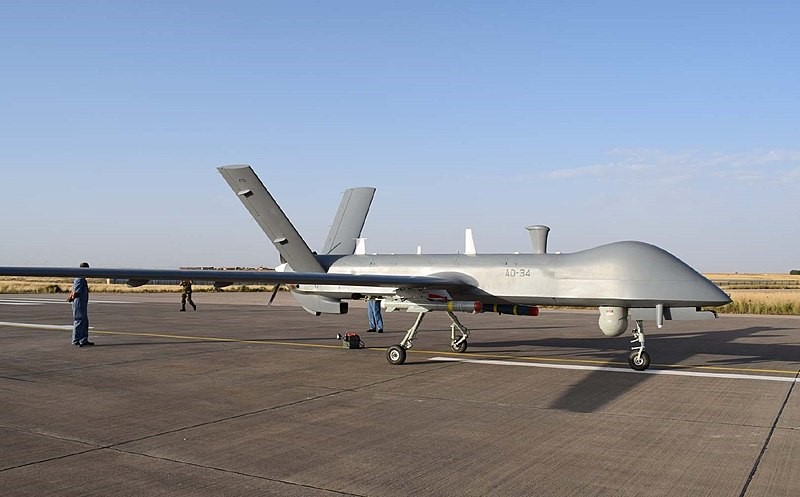
China Monitor is our brand-new program that analyses China’s economic and foreign policies. It also aims to predict the consequences of Beijing’s policy for the global economy, the EU as well as Central and Eastern European countries such as Poland.
Date: 31 December 2020
Author: Paweł Paszak
Are Military Drones the Future of the Chinese Army?
Unmanned aerial vehicles (UAVs/UCAVs) are a vital part of China’s strategy for winning “intelligent conflicts,” which are increasingly based on information flow and enhanced situational awareness. Between 2010 and 2020, China introduced a large number of advanced systems of this kind, becoming one of the world leaders in this sector. A wide range of military drones enables the People’s Liberation Army (PLA) to perform intelligence, reconnaissance and disruptive operations as well as direct attacks on enemy targets at relatively low cost. Conflicts in Nagorno-Karabakh, Syria and Donbass have shown that such units will play more and more significant role on the battlefield. Furthermore, the growth of the unmanned aerial vehicles sector opens up opportunities for Chinese arms exports, which in recent years have found numerous customers, mainly in Africa and the Middle East.

During the aforementioned period, PLA came into possession of the WZ-7 Soar Dragon reconnaissance drones (High-Altitude Long Endurance type, HALE) capable of operating at altitudes above 15,000 m (around 50,000 ft) and intended mainly for intelligence and reconnaissance missions. Its successor – WZ-8, was presented during a military parade on October 1, 2019. According to Chinese sources, it is able to achieve supersonic speed and has stealth technology, making it less visible to radars and more difficult to be detected by the enemy. WZ-7 and WZ-8 are expected to make up the satellites’ observation capabilities, which are limited by their orbital trajectories.
In 2020, the state-owned company NORINCO completed work on CR500 Golden Eagle unmanned helicopter, which is meant for export. The basic task of the unit would be to support armored forces, self-propelled artillery and infantry. It is supposed to facilitate locating enemy units by tanks and artillery as well as assess the inflicted damage. New CR500 will most likely go to regular recipients of Chinese armaments in the Middle East and Pakistan.
Furthermore, the Chinese unmanned aerial vehicles fleet includes MALE units (medium-altitude long-endurance). China has adapted domestic GJ-1 and GJ-2 models for export – internationally they are known as Wing Loong I and Wing Loong II. The newer model is able capable of carrying twelve air-to-surface missiles including: Lan Jian 7 (Blue Arrow 7), TG100 and AR-1/HJ-10 using laser guidance/GPS. It can reach a speed of up to 370 km/h (230 mph) and a height of 9,000 m (around 30,000 ft). GJ-2/Wing-Loong II is expected to be a cheaper alternative to American models, which are much more expensive. According to estimates, the cost of one drone is around 1-2 million dollars while the American MQ-9 Reaper is priced at 30 million dollars. A significant part of the Chinese drone fleet is made up of CH/Rainbow units produced by the CASC (China Aerospace Science and Technology Corporation) and gaining customers on both domestic and foreign markets. Among them, the CH-4 models, available in reconnaissance as well as mixed attack and reconnaissance variants, seem to be the most popular abroad. This model, similarly to the Wing Loong series, is recognized as the cheaper equivalent to the American MQ-9 Reaper.
Support Us
If content prepared by Warsaw Institute team is useful for you, please support our actions. Donations from private persons are necessary for the continuation of our mission.
Several countries have decided to buy Chinese drones in the last decade, including Algeria, Bangladesh, Egypt, Ethiopia, Indonesia, Jordan, Kazakhstan, Myanmar, Nigeria, Pakistan, Saudi Arabia, Serbia, Turkmenistan, United Arab Emirates, Uzbekistan and Zambia. The growing interest in Chinese military drones has led Beijing to become the largest exporter of this equipment in the world.
In recent years, there has been some residual information evidencing the works on the introduction of a large number of small and cheap drones armed with explosives, which will allow to use the “swarm tactics” to destroy enemy targets. A long-range unmanned aerial vehicle with stealth capabilities providing reconnaissance support for aircraft carrier strike groups is also under development. Research and tests are conducted by several companies and centers parallelly. Among the tested drones are the GJ-11 (manufactured by the Aviation Industry Corporation of China, AVIC) and CH-7 (produced by CASC), which are expected to be the equivalents to the American X-47b.
Unmanned aerial vehicles are still a component which supports the traditional armed forces, but their role is steadily growing, mainly in the area of improving situational awareness. The digitalization of the battlefield will increase the importance of the signals intelligence (SIGINT) capability involving the interception of electronic communication or tracking information flows. As this sector develops, land, air and naval units are expected to be widely equipped with various unmanned systems, serving reconnaissance, logistic and offensive purposes.
_________________________________
All texts published by the Warsaw Institute Foundation may be disseminated on the condition that their origin is credited. Images may not be used without permission.

















